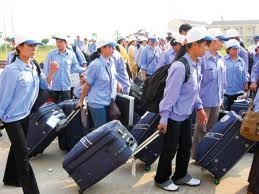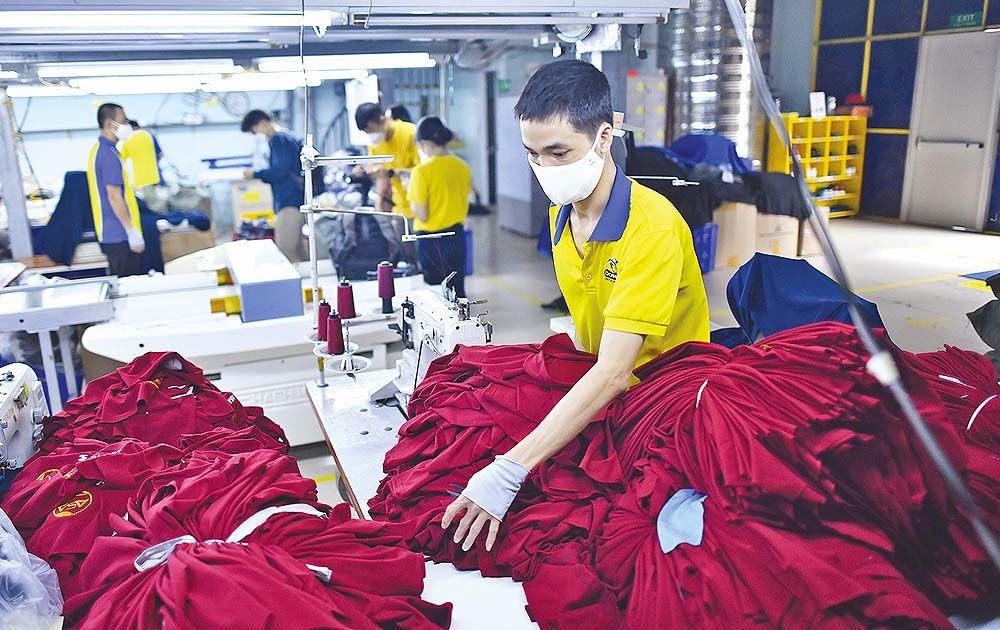Labour exports not plain sailing
 These are prominent issues reflected by a survey conducted during 2010-2011 by Ministry of Labour, Invalids and Social Affairs’ (MoLISA) Institute of Labour Science and Social Affairs (ILSSA) in eight Vietnamese locations featuring high rates of export labourers including Thai Binh, Phu Tho, Vinh Phuc, Bac Giang, Hai Duong, Thanh Hoa, Ha Tinh and Ho Chi Minh City.
These are prominent issues reflected by a survey conducted during 2010-2011 by Ministry of Labour, Invalids and Social Affairs’ (MoLISA) Institute of Labour Science and Social Affairs (ILSSA) in eight Vietnamese locations featuring high rates of export labourers including Thai Binh, Phu Tho, Vinh Phuc, Bac Giang, Hai Duong, Thanh Hoa, Ha Tinh and Ho Chi Minh City.
Japan, South Korea, Taiwan and Malaysia attract 70 per cent of Vietnamese labourers.
Accordingly, “the average income of export labourers is far higher than when they work in Vietnam. For instance, it is over seven times more for labourers going to work in Japan, 9.5-fold more for those in South Korea, nine times more for those in Taiwan and up 3.9 times for those working in Malaysia,” the survey read.
For a three-year contract, an export worker in Japan could save an average VND312 million ($14,800), in South Korea VND243 million ($11,500), in Taiwan VND145 million ($6,900) and in Malaysia VND51 million ($2,400).
“The problem is that top labour export markets report highest rates of absconders,” said MoLISA deputy minister Nguyen Thanh Hoa, citing that with incomes averaging VND10 million ($470), or even VND30 million ($1,400) per month Japan and South Korea are the top targets for the majority of local export labourers. However, these two markets also witness highest rates of absconders.
For instance, in South Korea every three export labourers terminated labour contracts, one absconded from returning home and stayed illegally in South Korea to continue working. Such rate is also the top among 15 nations signing contracts on labour export with South Korea.
ILSSA’s survey also pointed out the reason why the labourers absconded. That was chiefly because nearly 58 per cent of export labourers had to pay expenses for having the opportunity to work abroad many times higher than regulated amount.
For example, to work in South Korea many of them had to pay $10,000 against required amount $700. Most of the excessive amount was loans, so that a number of export labourers absconded after their contract termination and stayed in the host country to work illegally for extra earnings.
In other cases, firms operating in labour export service did not clearly explain contract terms to export labourers. Consequently, in foreign markets export labourers had to perform harmful work at low pay different to what they were promised before departing.
“Current woes in labour export mainly came from poor management,” said National Assembly’s Social Affairs Committee former deputy chairman Dang Nhu Loi.
Loi said only 30 per cent out of nearly 200 labour export service firms have been operating effectively.
ILSSA’s survey also shows after returning home export labourers have to use nearly 35 per cent of their savings abroad to pay associated debts. Of the remaining amount, nearly 29 per cent was spent on construction and house repair costs, around 11 per cent on luggage purchases while a little proportion was spent on production-business expansion (8.79 per cent) or study (3.67 per cent).
Besides, up to 76 per cent of export labourers could not find jobs after returning home, partly because export labour support policies are vague in content and localities lack the database about labour market and job information.
“What other countries are acting in this area must be taken as a useful reference to find out a remedy. We also need to weigh over how to assist export labourers after they return home,” said Hoa.
Over 40,000 Vietnamese labourers went to work abroad in 2012’s first five months, equalling 86.5 per cent compared to the same period in 2011 and tantamount to 44.6 per cent of the year’s projection, according to MoLISA’s Overseas Labour Management Department.
What the stars mean:
★ Poor ★ ★ Promising ★★★ Good ★★★★ Very good ★★★★★ Exceptional
Related Contents
Latest News
More News
- Mitsubishi Estate launches Logicross Hai Phong - a milestone in logistics evolution (November 20, 2024 | 14:32)
- Semiconductor workforce partnerships deliver industry-relevant training (November 20, 2024 | 10:58)
- German Quickpack to invest $31.7 million in Long An province (November 20, 2024 | 09:31)
- Foreign-invested enterprises drive logistics investment in the southeast region (November 20, 2024 | 09:27)
- Chile visit underscores trade benefits (November 19, 2024 | 10:00)
- Trump’s second term impacts sci-tech activities and industry 4.0 technologies (November 18, 2024 | 10:00)
- Vietnam eyes nuclear revival to bolster energy security (November 14, 2024 | 16:46)
- Kyokuyo completes $13.5 million seafood factory in Vietnam (November 14, 2024 | 12:19)
- VinFast receives $3.5 billion funding from Vingroup and Pham Nhat Vuong (November 14, 2024 | 06:38)
- Localities sprint to reach FDI targets (November 13, 2024 | 10:00)


 Tag:
Tag:




















 Mobile Version
Mobile Version